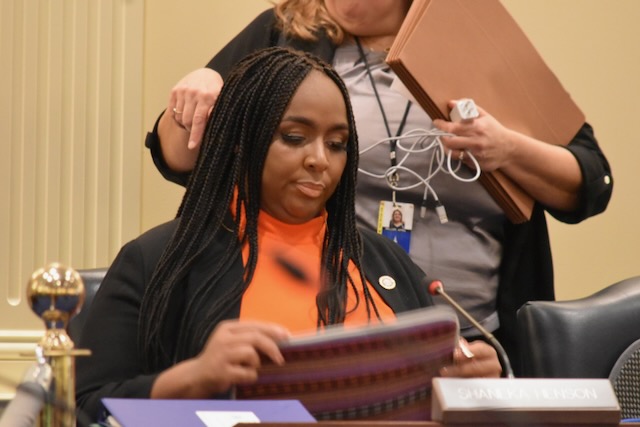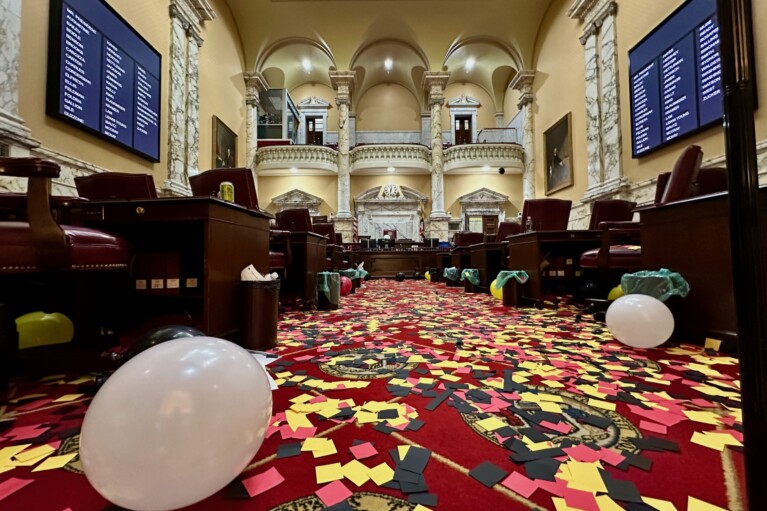Bathroom Parity, Lactation Room, Videostreaming: Jones Outlines Changes for 2020
As the first woman and first African-American to lead the House of Delegates, Speaker Adrienne A. Jones (D-Baltimore County) is already a living embodiment of changes taking place in Maryland government and politics.
Now, with her first session as speaker looming, Jones is hoping to modernize the tradition-bound institution she took over seven months ago.
In a memo to colleagues that she sent Wednesday, Jones announced “a few, but significant, changes that I have implemented” for the House. They are designed, she said in an interview, as customer service measures, for lawmakers and members of the public alike, to increase transparency and accessibility throughout the legislative complex.
Jones’ message covered a range of reforms, from video of House floor sessions, to bathrooms in the State House and House office buildings, to the way testimony is delivered to House committees, to the physical comfort of people who come to testify in Annapolis. The memo was first reported in The Baltimore Sun Wednesday.
While Jones’ note to her colleagues covered logistical details and the physical plant, she said she would send an additional memo right after New Year’s Day laying out her legislative priorities for 2020. The General Assembly session is set to begin on Jan. 8.
Jones’ predecessor, the late speaker Michael E. Busch (D), had already announced that the House would begin livestreaming floor sessions beginning in 2020 — they have been broadcast live on an audio feed for several years, a practice that will continue. But Jones said in her memo that she considers the video component a “pilot” for 2020, and that only about one-third of floor sessions would be livestreamed.
Jones told Maryland Matters that in all likelihood, the House would begin airing all floor sessions in 2021, when the state Senate is scheduled to do the same. She said this session the House would prioritize airing floor debates on the most high-profile issues, along with events like the governor’s State of the State speech and addresses from other dignitaries. Traditional events like the Martin Luther King Jr. Day speech and President’s Day speech would also be aired.
“It’s not going to be days when we come in at 10:00 and adjourn at 10:20,” Jones said, adding that she is interested in gauging whether the presence of TV cameras would change the length and tenor of floor debates.
“We want to see if this will take up more floor debate or not,” she said. “We’ll see.”
Jones said expected most lawmakers would not want to be seen as hogging the spotlight, but conceded, “Anything’s possible.”
“I think it depends on who the legislator is, to be honest,” she said.
In her memo, Jones told her colleagues that lawmakers’ names, district numbers and counties would be flashed on a chyron when they are talking. She also warned them to make sure the laptops they use on the House floor have privacy screens so that the TV cameras don’t inadvertently transmit their private messages.
Jones said the House will also use technology to make committee proceedings more efficient. Members of the public will be able to sign up to testify at hearings electronically, and they will be instructed, where possible, to deliver their written testimony electronically as well. Lawmakers will be able to upload testimony on their laptops, so they aren’t burdened with reams of paper.
Last year, the House Environment and Transportation Committee collected testimony electronically as a pilot project, and members appreciated it, said the committee chairman, Del. Kumar P. Barve (D-Montgomery).
“I think it’s terrific,” he said. “It’s really nice not to have that stack of paper that’s going to go in the recycling bin.” Barve said even skeptics on his committee “adjusted within a couple of weeks.”
Meanwhile, Jones reported that bathrooms off the lounge behind the House chamber had been converted so that there are now three men’s bathrooms, three women’s bathrooms, and one gender-neutral bathroom. Previously, there had been more men’s bathrooms than women’s.
“I hope that this will help alleviate any wait times for members during the legislative session as well as firmly communicate the House’s support of gender inclusivity,” Jones asserted in her memo.
In the interview with Maryland Matters, she noted, “We have a record number of women in our caucus.” Just over half of the House Democrats are women.
Asked if the inclusion of a unisex bathroom anticipated the possibility of a transgender lawmaker one day serving in the House, Jones replied, “I know it probably will happen.”
The speaker said that a lactation room is being set up in the House office buildings and that men’s bathrooms in the House now include changing tables for babies.
Lastly, Jones said the House would be using new surplus chairs, ordered for members’ offices, to provide a dozen waiting areas for the public in the House office buildings. There are times during busy days of session when members of the public, waiting for hearings to begin or meetings to take place, are milling around the hallways because they have no place to go.
“We want to encourage citizens to be a part of the legislative process and this is a small step to making them feel more welcome,” she said.




 Creative Commons Attribution
Creative Commons Attribution